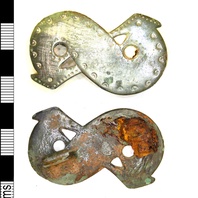
Viking Objects
Frankish Zoomorphic Brooch (LEIC-06202B)
The design of this brooch suggests that it was of Frankish manufacture and dates to roughly 600-700 AD. It is possible that it made its way to England prior to Viking incursions but it is equally likely that the Vikings brought this brooch with them as plunder after raiding in Frankia. For more information on Scandinavian jewellery in England check out our blog: Brooches, Pendants and Pins: Scandinavian Dress Accessories in England.
Read More
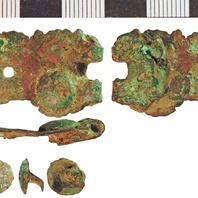
Viking Objects
Frankish Trefoil Buckle (NLM-60D592)
This cast copper-alloy buckle plate is trefoil in form and has traces of gilding which appear on the display side. The use of tripled domed rivets is similar to Frankish buckle styles introduced from the seventh century, while the use of gilding may relate this to eighth-century styles. It is possible that it made its way to England prior to Viking incursions but it is equally likely that the Vikings brought this buckle with them as plunder after raiding in Frankia.
Read More
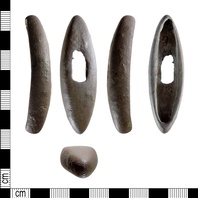
Viking Objects
Sword Hilt or Top Guard (DENO-87124F)
A copper-alloy hilt or top guard from an early medieval, possibly Viking, sword or dagger.
Read More
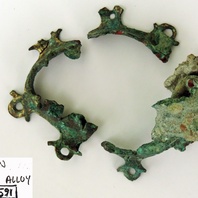
Viking Objects
Gilded Mount (1989-59/7591)
A gilded copper-alloy mount with approximately eight projecting pierced lugs. The mount was found in three pieces and is incomplete. It may originally have been domed, but most of the dome is missing. It has been suggested that it was a shield boss.
Read More
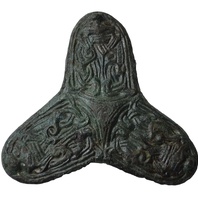
Viking Objects
Trefoil brooch (LCNCC : 2011.99)
A trefoil brooch with Borre/Jellinge-style cast ornament belonging to Peterson’s type 109. The brooch is most probably cast of copper alloy with traces of gilding on its upper surface and white metal plating on the reverse. While of Scandinavian design, many examples found in the East Midlands were probably made in the Danelaw, and may have been copies of Scandinavian styles, instead of being imported from Scandinavia. For more information on Scandinavian jewellery in England check out our blog: Brooches, Pendants and Pins: Scandinavian Dress Accessories in England.
Read More
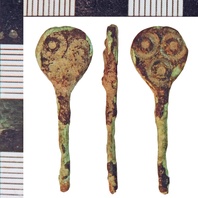
Viking Objects
Ring-and-Dot Pin (NLM-7A2D15)
Copper-alloy cast pin with a flat discoid head, no collar, and stamped decoration on the head, Flixborough type 601. The head bears three large [diameter 4.4mm] ring-and-dot motifs on each of its opposed faces. The tip of the shank is lost. The introduction of flat-headed pins with ring-and-dot decoration, superseding other types, is held by Dave Haldenby to mark the arrival of Viking settlers at Cottam, East Riding of Yorkshire. Suggested date: Early Medieval, 865-925. The finder suggests this to be part of an assemblage amounting to c.5% of material recovered from an extensive site, the rest being removed illicitly without record. Archaeological opinion holds the site to have been of equivalent character to Flixborough, North Lincolnshire, in terms of its material culture. Coins are under-represented in the group.
Read More
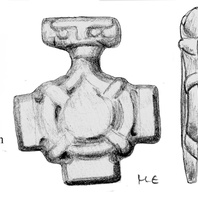
Viking Objects
Die Stamp (NLM-690F57)
This cast copper-alloy die was used in the process of making filigree pendants of the Hiddensee-Rügen type, more specifically, to create pressed silver or gold sheet appliqués, which were applied to a pendant back-plate and used as a base for filigree and granulation work. The ring in the centre creates a closed ring-knot motif related to the Scandinavian Borre style. The Hiddensee-Rügen style is named after the gold jewellery hoard discovered in the late nineteenth century on the island of Hiddensee, off the Baltic coast of Germany. The Swinhope die is one of a small group of recorded objects used in the production of Hiddensee-style cruciform pendants. No finished pendants of the type represented by the Swinhope die are known, either from England or Scandinavia.
Read More
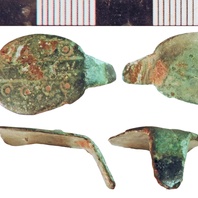
Viking Objects
Copper-Alloy Finger-Ring (NLM-D4A8C9)
A copper-alloy cast finger-ring featuring circular punched ring and dot decoration. Ring and dot was a decorative technique used at various periods from the later Iron Age onwards, but which enjoyed a Viking Age revival.
Read More
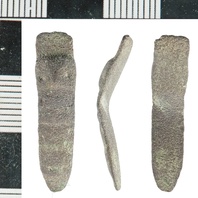
Viking Objects
Copper-Alloy Strap-End (NLM-7415FD)
This copper-alloy strap-end is decorated with vaguely zoomorphic decoration and is possibly a Thomas Class B type 4. The reddish tint of the metal is often characteristic of Anglo-Scandinavian metalwork. Strap-ends came in various styles and were fairly common throughout the Viking world. They were used to decorate the ends of belts and to stop them getting damaged.
Read More
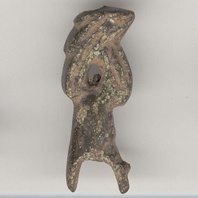
Viking Objects
Prick Spur (LIN-DC6E82)
Early spurs had a neck that ended in a point, called a prick, riveted to the heel band. This object is a fragment of the prick and is cylindrical in section. It is broken at the lowest point where it divides into two arms. There is a hollow shaft above leading into two decorative crescent-shaped arms, one arching over the other. Each arm is longitudinally ribbed. The very top of the object is also pierced, allowing something to pass vertically through the entire object.
